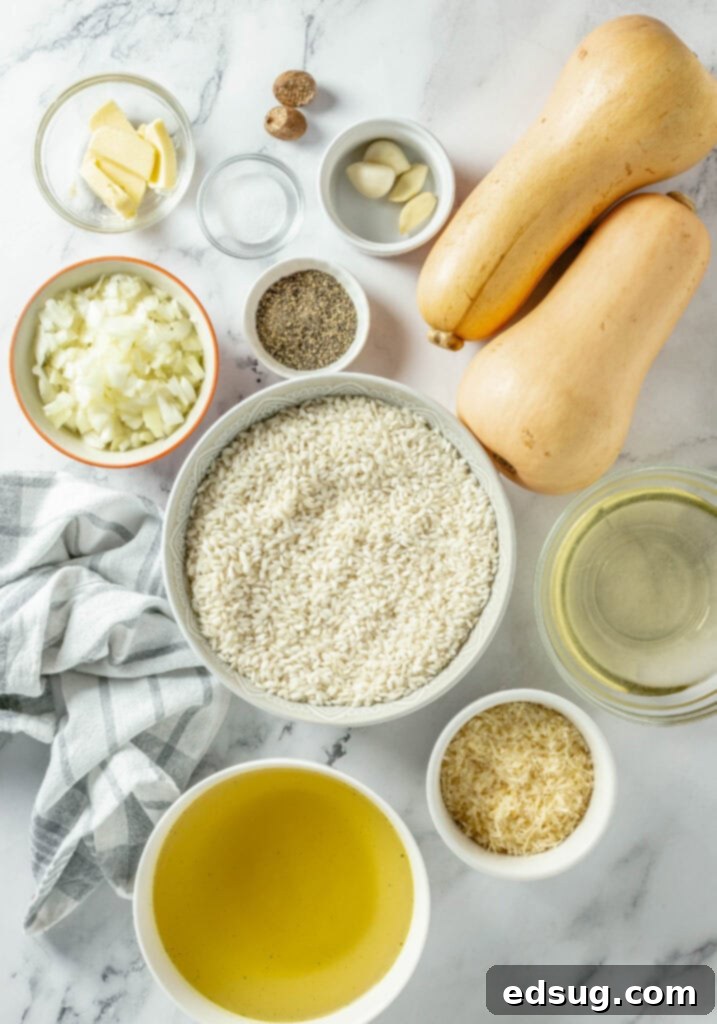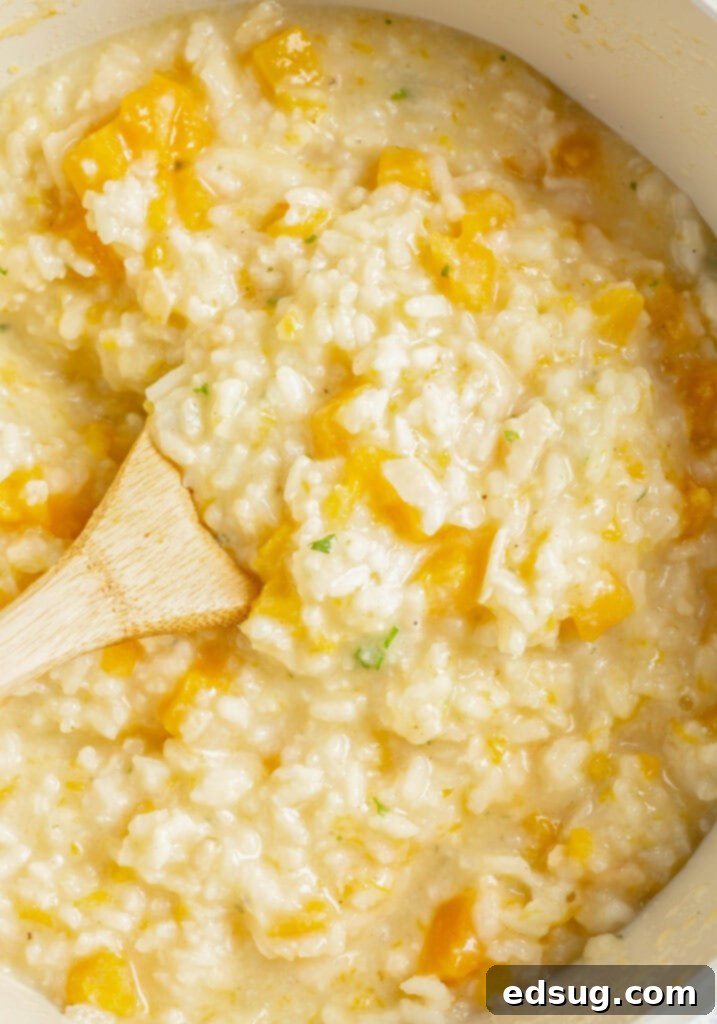Creamy Butternut Squash Risotto: The Ultimate Fall Comfort Food Recipe
Indulge in the rich, velvety texture and sweet, earthy flavors of this exquisite Butternut Squash Risotto. A perfect dish for the crisp days of autumn, this recipe guides you to create a perfectly comforting, simple-to-make, and utterly delicious risotto, bursting with roasted butternut squash. It’s a culinary experience that feels incredibly gourmet yet is surprisingly straightforward to master in your own kitchen.
Risotto often carries a reputation for being a complex, fancy dish best left to professional chefs. However, that couldn’t be further from the truth! With the right techniques and a touch of patience, crafting a truly exceptional risotto at home is not only achievable but immensely rewarding. For years, our Sausage and Mushroom Risotto has been a family favorite, proving that this Italian classic is much more accessible than many believe. While dining out, if risotto appears on a menu, I’m almost always tempted to order it. Yet, the quality can be incredibly inconsistent, often falling short of that ideal creamy, tender consistency. That’s why I’m thrilled to share all the essential tips and tricks you need to ensure your homemade butternut squash risotto turns out perfectly creamy and flavorful every single time.
Why This Butternut Squash Risotto Will Be Your New Fall Favorite
This Butternut Squash Risotto isn’t just a meal; it’s an experience. It brings together the warmth and coziness characteristic of fall cooking with the sophisticated appeal of a well-executed Italian dish. What makes this recipe truly special is the harmonious blend of textures and tastes: the delicate sweetness of the roasted butternut squash, the savory depth from the broth and Parmesan, and the signature creaminess that defines a great risotto. It’s an ideal choice for a festive holiday gathering, a special occasion, or simply a comforting weeknight dinner. Furthermore, with simple substitutions, it can easily cater to vegetarian and even vegan dietary preferences, making it a versatile addition to any recipe repertoire.

The Foundation of Great Risotto: Understanding Arborio Rice
At the heart of any truly great risotto lies Arborio rice. This specific variety of short-grain Italian white rice is not interchangeable with your everyday long-grain rice, and understanding why is key to achieving that signature creamy texture. Arborio rice grains are plump and oval-shaped, characterized by their high starch content, specifically amylopectin. When cooked slowly and stirred consistently, this starch is released, creating a luscious, creamy sauce that coats each grain, while the core of the rice remains slightly firm – a desirable quality known as “al dente.”
Unlike long-grain rice, which tends to cook up fluffy and distinct, Arborio rice absorbs liquid gradually, releasing its starches and thickening the cooking liquid into a rich, velvety consistency. This unique property is what gives risotto its distinctive character. You can typically find Arborio rice in most well-stocked grocery stores, often located near other rice varieties or in the international foods aisle. While it might be a bit more expensive than standard rice, the exceptional results it yields in this recipe make it an absolutely worthwhile investment for an authentic and delightful risotto experience.
Essential Ingredients for a Flavorful Butternut Squash Risotto
Crafting the perfect butternut squash risotto relies on a selection of fresh, high-quality ingredients that work together to build a symphony of flavors and textures. Here’s a closer look at what you’ll need and why each component is crucial:
- Butter: The foundation of our creamy risotto, butter provides richness and helps to sauté the aromatics beautifully, laying the groundwork for deep flavor.
- Onion: Finely chopped, onion forms the aromatic base, slowly caramelizing to add a subtle sweetness and depth to the dish as it cooks.
- Garlic: A classic aromatic, minced garlic infuses the risotto with its pungent, savory notes, perfectly complementing the inherent sweetness of the squash.
- Dry White Wine: This is a crucial step not just for deglazing the pan and picking up flavorful bits, but also for adding a layer of sophisticated acidity and complexity that elevates the overall flavor profile. Choose a dry white wine like Pinot Grigio or Sauvignon Blanc for best results.
- Arborio Rice: As discussed, this is the undisputed star. Its short, plump grains are rich in amylopectin starch, released during cooking to create that signature creamy consistency.
- Chicken Broth: The liquid backbone of the risotto. Using warm broth is absolutely key, as it prevents cooling the rice down each time you add liquid, ensuring a consistent cooking temperature for optimal starch release and a smooth cooking process. For a vegetarian option, simply use vegetable broth.
- Parmesan Cheese: Freshly grated Parmesan adds a salty, umami kick and contributes significantly to the risotto’s irresistible creaminess at the final stage. The quality of your Parmesan truly makes a difference here.
- Butternut Squash: The namesake ingredient. Roasting the squash beforehand intensely concentrates its natural sweetness and allows it to break down slightly into the risotto, enhancing both flavor and texture.
- Salt & Pepper: Essential seasonings to balance and enhance all the flavors. Remember to taste and adjust to your personal preference throughout the cooking process.
- Fresh Grated Nutmeg: A small pinch of nutmeg beautifully complements the sweetness of the butternut squash, adding a warm, aromatic, and slightly spicy note that ties all the fall flavors together.
- Pumpkin Seeds: Used as a garnish, these provide a delightful crunch and nutty flavor contrast to the smooth, creamy risotto.
- Fresh Sage or Parsley: Chopped fresh herbs brighten the dish and add a final touch of herbaceous aroma and color. Fresh sage, in particular, has a wonderful affinity for squash.

How to Cook Butternut Squash Risotto: A Step-by-Step Guide for Perfection
Making risotto is more about technique and timing than it is about complex steps. Follow these instructions carefully to achieve a restaurant-quality dish right at home:
- Roast the Butternut Squash: Start by preheating your oven to 425º F (220º C). Dice your butternut squash into small, uniform pieces (about 1/2 inch). Toss them with a tablespoon of olive oil, salt, and pepper, then spread them in a single layer on a baking sheet. Roast for about 15 minutes, or until the squash just begins to soften and lightly caramelize. Roasting first deepens its flavor and allows it to “melt” into the risotto more easily, creating extra creaminess. If you’re short on time, you can skip this step and add raw, finely diced squash directly to the rice, though the flavor won’t be as intense.
- Prepare Your Broth: Pour the chicken broth (or vegetable broth) into a separate saucepan. Place it over medium-low heat and keep it warm. This step is crucial; adding cold broth to the hot rice would shock it, disrupt the cooking process, and hinder starch release, leading to a less creamy risotto.
- Sauté Aromatics: In a large, heavy-bottomed skillet or Dutch oven, melt the butter over medium heat. Add the finely chopped onion and sauté gently until it becomes soft, translucent, and fragrant, usually about 5-7 minutes. Avoid browning.
- Add Garlic and Rice: Stir in the minced garlic and the Arborio rice. Cook for about 1-2 minutes, stirring constantly. This “toasting” step, known as tostatura, lightly toasts the exterior of the rice grains, helping them maintain their shape and develop a nutty flavor. You’ll smell the garlic’s aroma as it cooks.
- Deglaze with White Wine: Pour in the dry white wine. Stir continuously, allowing the wine to simmer and evaporate almost completely. This process deglazes the pan, incorporating any caramelized bits from the bottom, and infuses the rice with a subtle, bright acidity.
- Incorporate Squash and Broth Gradually: Once the wine has mostly evaporated, stir in the roasted butternut squash pieces. Then, add one ladleful (about 1/2 to 3/4 cup) of the warm chicken broth to the rice. Reduce the heat to medium-low, ensuring the risotto is at a gentle simmer, not a vigorous boil.
- Stir and Absorb: Continue adding broth one ladleful at a time, stirring frequently. Allow almost all of the liquid to be absorbed by the rice before adding the next ladleful. This constant stirring helps to release the starches from the Arborio rice, creating the characteristic creamy texture. This process will take approximately 25-30 minutes, or until the rice is tender with a slight bite (al dente) and the entire mixture is thick and creamy.
- Finish and Season: Once the rice has reached its perfect tenderness, remove the skillet from the heat. Stir in the grated Parmesan cheese, season generously with salt and pepper to taste, and add a small pinch of fresh grated nutmeg. Stir vigorously for about a minute to fully emulsify the cheese and create maximum creaminess.
- Serve Immediately: Ladle the creamy butternut squash risotto into warm bowls. Garnish with a sprinkle of pumpkin seeds for crunch and a flourish of chopped fresh sage or parsley for a burst of fresh flavor and color. Risotto is best served immediately, as it tends to thicken as it cools.

Expert Tips for the Best Butternut Squash Risotto
Achieving risotto perfection is all about understanding a few key principles. Keep these tips in mind for an effortlessly delicious outcome:
- Patience is Key: Risotto is not a dish to rush. The slow, gradual addition of broth and frequent stirring are essential for developing that signature creamy texture. Keep the heat at a gentle simmer; a hard boil will cook the rice too quickly externally without allowing proper starch release.
- Warm Broth is Non-Negotiable: As mentioned, always use warm broth. Cold broth will lower the temperature of the rice, interrupting the cooking process and affecting the starch extraction, which is vital for creaminess.
- Knowing When It’s Done: The risotto is ready when the rice is tender but still has a slight chew (al dente). It should not be mushy. The entire mixture should be thick, creamy, and spreadable, not soupy or stiff. When you drag a spoon across the bottom of the pan, the risotto should slowly ooze back together. Don’t be afraid to add a little more broth if needed to reach this consistency, as factors like humidity can affect liquid absorption.
- Roasting the Squash: Roasting the butternut squash truly enhances its flavor, making it sweeter and more aromatic. It also helps the squash break down more easily into the risotto, boosting creaminess. If you opt not to roast, make sure to dice the raw squash into very small pieces so it cooks fully with the rice. The final texture might be slightly different, but it will still be delicious.
- Shortcuts for Busy Days: If you’re really pressed for time, you can roast the squash while the risotto is cooking and stir it in at the very end. While the flavor integration might not be as deep as when it cooks with the rice for longer, it’s a perfectly acceptable time-saving alternative.
- Constant, Gentle Stirring: You don’t need to stir constantly for 30 minutes, but frequent stirring is essential. This helps to abrade the rice grains, releasing their starches, and prevents them from sticking to the bottom of the pan.
Storage and Reheating Butternut Squash Risotto
This recipe makes a generous amount of delicious risotto, so leftovers are a welcome treat! Store any uneaten portions in an airtight container in the refrigerator for 4-5 days. While risotto is best enjoyed freshly made, reheating it carefully can still yield a delightful meal.
To reheat, place the risotto in a saucepan over medium-low heat, adding a splash of chicken or vegetable broth (or even water) to help rehydrate it and restore its creamy consistency. Stir gently and continuously until heated through, adding more liquid as needed to achieve your desired texture. Avoid reheating it in the microwave if possible, as it can often dry out the rice and make it less appealing.
Vegetarian and Vegan Adaptations: This Butternut Squash Risotto is incredibly versatile. To make it a wonderful vegetarian meal, simply substitute chicken broth with an equal amount of high-quality vegetable broth. For a completely vegan version, use a plant-based butter alternative (like olive oil or a vegan butter spread) and a dairy-free Parmesan cheese substitute. These minor adjustments allow everyone to enjoy this comforting autumn dish.
What to Serve with Butternut Squash Risotto
Butternut Squash Risotto is wonderfully versatile and can be enjoyed as a luxurious main course or a sophisticated side dish. Here are some excellent pairing ideas:
- As a Main Dish: This risotto is hearty enough to stand on its own, especially when topped with extra pumpkin seeds and fresh herbs.
- With Grilled or Roasted Meats: Its rich flavor complements protein beautifully.
- Sous Vide Steak for an elegant touch.
- Tender Lamb Chops.
- Savory Honey Dijon Chicken.
- Light and Fresh Sides: A crisp salad provides a refreshing contrast.
- A Simple Tossed Salad with a light vinaigrette.
- Steamed green beans or asparagus.
- Crusty Bread: Perfect for soaking up any leftover creamy goodness.
- Warm, crusty baguette or Italian Cheese Pull Apart Bread.

Frequently Asked Questions About Butternut Squash Risotto
- Can I make risotto ahead of time?
- Risotto is truly best served immediately. As it cools, the starches in the rice continue to set, making it thicken considerably and lose its delicate creaminess. While you can store leftovers and reheat, the texture will never be quite as perfect as fresh.
- What kind of white wine should I use?
- Choose a dry white wine that you would enjoy drinking, such as Pinot Grigio, Sauvignon Blanc, or an unoaked Chardonnay. Avoid sweet wines, as they will alter the flavor profile of the risotto.
- Can I use a different type of squash?
- Yes, absolutely! While butternut squash is ideal for its sweetness and creamy texture when cooked, you could experiment with other winter squashes like acorn squash, delicata squash, or even pumpkin. Just ensure they are diced small enough to cook properly.
- Is risotto truly difficult to make?
- Not at all! Risotto has a reputation for being tricky, but it’s more about attention and technique than difficulty. The key is consistent stirring, gradual broth addition, and patience. Once you’ve made it a few times, it becomes second nature.
- Why is my risotto not creamy?
- This is usually due to one of two reasons: not stirring enough (which prevents starch release) or not using warm broth (which interferes with consistent cooking and starch release). Ensure your broth is hot and you’re stirring frequently to encourage that creamy texture.
More Delicious Squash Recipes to Explore
If you’re a fan of the versatile and nutritious squash, you’ll love these other autumn-inspired recipes:
- Simple Roasted Butternut Squash
- Warming Curried Squash Soup
- Elegant Roasted Squash & Goat Cheese Salad
- Hearty Fall Couscous Salad
- Flavorful Sausage Stuffed Acorn Squash

Butternut Squash Risotto Recipe

By: Erin Sellin
Butternut Squash Risotto – a creamy risotto that is perfect for fall. Perfectly comforting, simple to make, loaded with roasted butternut squash and absolutely delicious!
Prep Time: 15 mins
Cook Time: 45 mins
Total Time: 1 hr
Servings: 5
Ingredients
Risotto
- 4 Tbsp butter
- 1 large onion, finely chopped
- 3 cloves garlic, minced
- 2/3 cup dry white wine
- 1 3/4 cups Arborio rice
- 4 cups chicken broth (warm)
- 3/4 cup grated Parmesan cheese
- 1/4 tsp fresh grated nutmeg
- Salt and pepper to taste
Roasted Squash
- 1 Tbsp olive oil
- 3 1/2 cups diced butternut squash
- Salt and pepper to taste
Garnish
- Pumpkin Seeds
- Chopped Sage or Parsley
Instructions
- Preheat oven to 425º F (220º C).
- Toss diced squash with olive oil, salt, and pepper. Arrange in a single layer on a baking sheet and cook for 15 minutes until it just starts to soften.
- Pour chicken broth into a saucepan and heat over medium heat to keep it warm.
- Using a large skillet or Dutch oven, melt butter over medium heat. Add onion and cook until it is soft and translucent.
- Mix in the garlic and rice and cook for 1-2 minutes until you can start to smell the garlic.
- Pour in the wine and let it simmer for a few minutes until it mostly evaporates.
- Stir in the roasted squash pieces, and then mix in a ladle full of warm chicken broth. Reduce heat to medium-low, ensuring the risotto lightly simmers, and stir frequently.
- As soon as most of the broth is absorbed, stir in another ladle full of broth. Continue this process until the rice is cooked. It will take 25-30 minutes for all of the broth to be absorbed by the rice and for it to be creamy and tender.
- Once the rice is tender, stir in the Parmesan cheese, season with salt and pepper, and a little nutmeg.
- Serve topped with a few pumpkin seeds and chopped sage or parsley.
Notes
- Use vegetable broth to make this dish vegetarian.
- Refer to the post above for additional tips and shortcuts for preparing the butternut squash.
Nutrition
Serving: 1g | Calories: 351kcal | Carbohydrates: 40g | Protein: 9g | Fat: 16g | Saturated Fat: 8g | Polyunsaturated Fat: 7g | Cholesterol: 34mg | Sodium: 1010mg | Fiber: 6g | Sugar: 4g
Nutrition information is automatically calculated, so should only be used as an approximation.
Additional Info
Author: Erin Sellin
Prep Time: 15 minutes
Cook Time: 45 minutes
Total Time: 1 hour
Course: Dinner Recipes
Cuisine: American
Servings: 5
Calories: 351
Like this recipe? Leave a comment below!
I created a fun group on Facebook, and I would love for you to join us! It’s a place where you can share YOUR favorite recipes, ask questions, and stay updated on what’s new at Dinners, Dishes and Desserts (so that you never miss a new recipe)!
Be sure to follow me on Instagram and tag #dinnersdishes so I can see all the wonderful DINNERS, DISHES, AND DESSERTS recipes YOU make!
Be sure to follow me on my social media, so you never miss a post!
Facebook | Twitter | Pinterest | Instagram
